Membrane-bound steel factor maintains a high local concentration for mouse primordial germ cell motility, and defines the region of their migration
- PMID: 21998739
- PMCID: PMC3188585
- DOI: 10.1371/journal.pone.0025984
Membrane-bound steel factor maintains a high local concentration for mouse primordial germ cell motility, and defines the region of their migration
Abstract
Steel factor, the protein product of the Steel locus in the mouse, is a multifunctional signal for the primordial germ cell population. We have shown previously that its expression accompanies the germ cells during migration to the gonads, forming a "travelling niche" that controls their survival, motility, and proliferation. Here we show that these functions are distributed between the alternatively spliced membrane-bound and soluble forms of Steel factor. The germ cells normally migrate as individuals from E7.5 to E11.5, when they aggregate together in the embryonic gonads. Movie analysis of Steel-dickie mutant embryos, which make only the soluble form, at E7.5, showed that the germ cells fail to migrate normally, and undergo "premature aggregation" in the base of the allantois. Survival and directionality of movement is not affected. Addition of excess soluble Steel factor to Steel-dickie embryos rescued germ cell motility, and addition of Steel factor to germ cells in vitro showed that a fourfold higher dose was required to increase motility, compared to survival. These data show that soluble Steel factor is sufficient for germ cell survival, and suggest that the membrane-bound form provides a higher local concentration of Steel factor that controls the balance between germ cell motility and aggregation. This hypothesis was tested by addition of excess soluble Steel factor to slice cultures of E11.5 embryos, when migration usually ceases, and the germ cells aggregate. This reversed the aggregation process, and caused increased motility of the germ cells. We conclude that the two forms of Steel factor control different aspects of germ cell behavior, and that membrane-bound Steel factor controls germ cell motility within a "motility niche" that moves through the embryo with the germ cells. Escape from this niche causes cessation of motility and death by apoptosis of the ectopic germ cells.
Conflict of interest statement
Figures
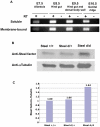
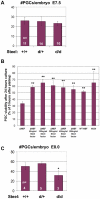
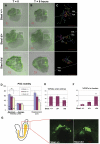
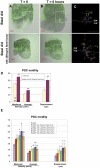
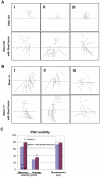

Similar articles
-
Steel factor controls primordial germ cell survival and motility from the time of their specification in the allantois, and provides a continuous niche throughout their migration.Development. 2009 Apr;136(8):1295-303. doi: 10.1242/dev.030619. Epub 2009 Mar 11. Development. 2009. PMID: 19279135
-
Steel factor controls midline cell death of primordial germ cells and is essential for their normal proliferation and migration.Development. 2006 Dec;133(24):4861-9. doi: 10.1242/dev.02688. Epub 2006 Nov 15. Development. 2006. PMID: 17107997
-
Effects of the steel gene product on mouse primordial germ cells in culture.Nature. 1991 Aug 29;352(6338):807-9. doi: 10.1038/352807a0. Nature. 1991. PMID: 1715517
-
Interactions between migratory primordial germ cells and cellular substrates in the mouse.Ciba Found Symp. 1994;182:140-50; discussion 150-3. doi: 10.1002/9780470514573.ch8. Ciba Found Symp. 1994. PMID: 7530618 Review.
-
Primordial germ cell migration.Ciba Found Symp. 1994;182:121-34; discussion 134-9. doi: 10.1002/9780470514573.ch7. Ciba Found Symp. 1994. PMID: 7530617 Review.
Cited by
-
Alterations of oncogenes expression in NK cells in patients with cancer.Immun Inflamm Dis. 2017 Dec;5(4):493-502. doi: 10.1002/iid3.179. Epub 2017 Jul 10. Immun Inflamm Dis. 2017. PMID: 28695716 Free PMC article.
-
Stem cell factor in the serum of patients with esophageal cancer in relation to its histological types.Arch Med Sci. 2017 Oct;13(6):1357-1364. doi: 10.5114/aoms.2016.61695. Epub 2016 Aug 9. Arch Med Sci. 2017. PMID: 29181066 Free PMC article.
-
Cell-intrinsic reprogramming capability: gain or loss of pluripotency in germ cells.Reprod Med Biol. 2012 Jun 19;12(1):1-14. doi: 10.1007/s12522-012-0131-z. eCollection 2013 Jan. Reprod Med Biol. 2012. PMID: 29699125 Free PMC article. Review.
-
Germline stem cells in human.Signal Transduct Target Ther. 2022 Oct 2;7(1):345. doi: 10.1038/s41392-022-01197-3. Signal Transduct Target Ther. 2022. PMID: 36184610 Free PMC article. Review.
-
A role for hedgehog signaling in the differentiation of the insertion site of the patellar tendon in the mouse.PLoS One. 2013 Jun 10;8(6):e65411. doi: 10.1371/journal.pone.0065411. Print 2013. PLoS One. 2013. PMID: 23762363 Free PMC article.
References
-
- Hayashi K, de Sousa Lopes SM, Surani MA. Germ cell specification in mice. Science. 2007;316:394–396. - PubMed
-
- Ohinata Y, Payer B, O'Carroll D, Ancelin K, Ono Y, et al. Blimp1 is a critical determinant of the germ cell lineage in mice. Nature. 2005;436:207–213. - PubMed
-
- Anderson R, Copeland TK, Scholer H, Heasman J, Wylie C. The onset of germ cell migration in the mouse embryo. Mech Dev. 2000;91:61–68. - PubMed
-
- Gu Y, Runyan C, Shoemaker A, Surani A, Wylie C. Steel factor controls primordial germ cell survival and motility from the time of their specification in the allantois, and provides a continuous niche throughout their migration. Development. 2009;136:1295–1303. - PubMed
-
- Molyneaux KA, Stallock J, Schaible K, Wylie C. Time-lapse analysis of living mouse germ cell migration. Dev Biol. 2001;240:488–498. - PubMed
Publication types
MeSH terms
Substances
Grants and funding
LinkOut - more resources
Full Text Sources
Molecular Biology Databases

